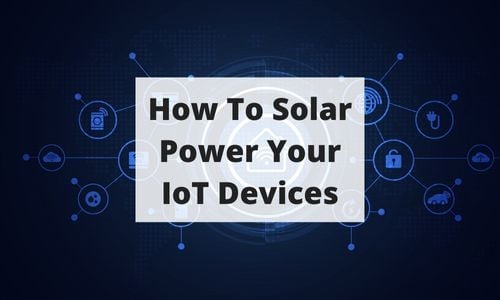Posted on 05/18/2018 at 12:00 by
Daniel Stieler, Phd

It seems that everywhere you go these days people are talking about IoT.
Whether it’s smart light bulbs that respond to your voice or sensors that transmit data, these devices are everywhere.
While IoT growth is staggering it will undoubtedly run into some future issues.
One of the major barriers to the mass deployment of wireless IoT sensors is battery lifetime.
Depending on power requirements, a primary battery will last a few months to a few years.
Short battery life adds significant cost to a system over its lifetime. The batteries themselves may be inexpensive, but labor and repeated replacements can add significant costs over a product’s lifecycle.
For example, a Bluetooth light/temperature sensor for HVAC/occupancy monitoring that sends data about once per second will consume about 1.5mWh of power each day. If a common CR2032 battery (225mAh, 675mWh) is used to power the system, then the system will operate for about 14 months.
This assumes that the battery will supply the full rated capacity, which will probably not be the case since the battery is rated at a 0.2mA continuous discharge and the peak radio transmit current is over 10mA.
This high current pulse over the life of the system will result in approximately a 10% decrease in capacity, so a year is probably a more realistic operation time.
The batteries cost less than $0.30, so not a major cost, however, the labor to replace the batteries will be greater than $10 per hour.
If the sensors are deployed on a large campus, there could easily be a thousand rooms to monitor. Assume that battery replacement times average of 10 minutes per sensor. It would take an employee 166 hours or just over 4 weeks per year to replace the batteries.
Therefore, annual sensor maintenance would cost about $2,000.
This figure is very conservative and assumes an employee working for slightly above minimum wage with no benefits and no consideration for the cost of sourcing and inventorying batteries. Also, labor time could be significantly higher depending on the amount of time it takes to travel to the location of each sensor.
One solution to this problem is the integration of a solar panel into the system. Solar panels can harvest light energy both indoors and outdoors providing a source of consistent power and increasing the lifetime of your product while simultaneously decreasing the total cost to your customer.
Solar is capable of harvesting significantly more power than many other sources including electrodynamic switches, piezoelectrics, ambient RF, and small temperature differential thermoelectrics.
Have any questions? Contact us or leave a comment below.